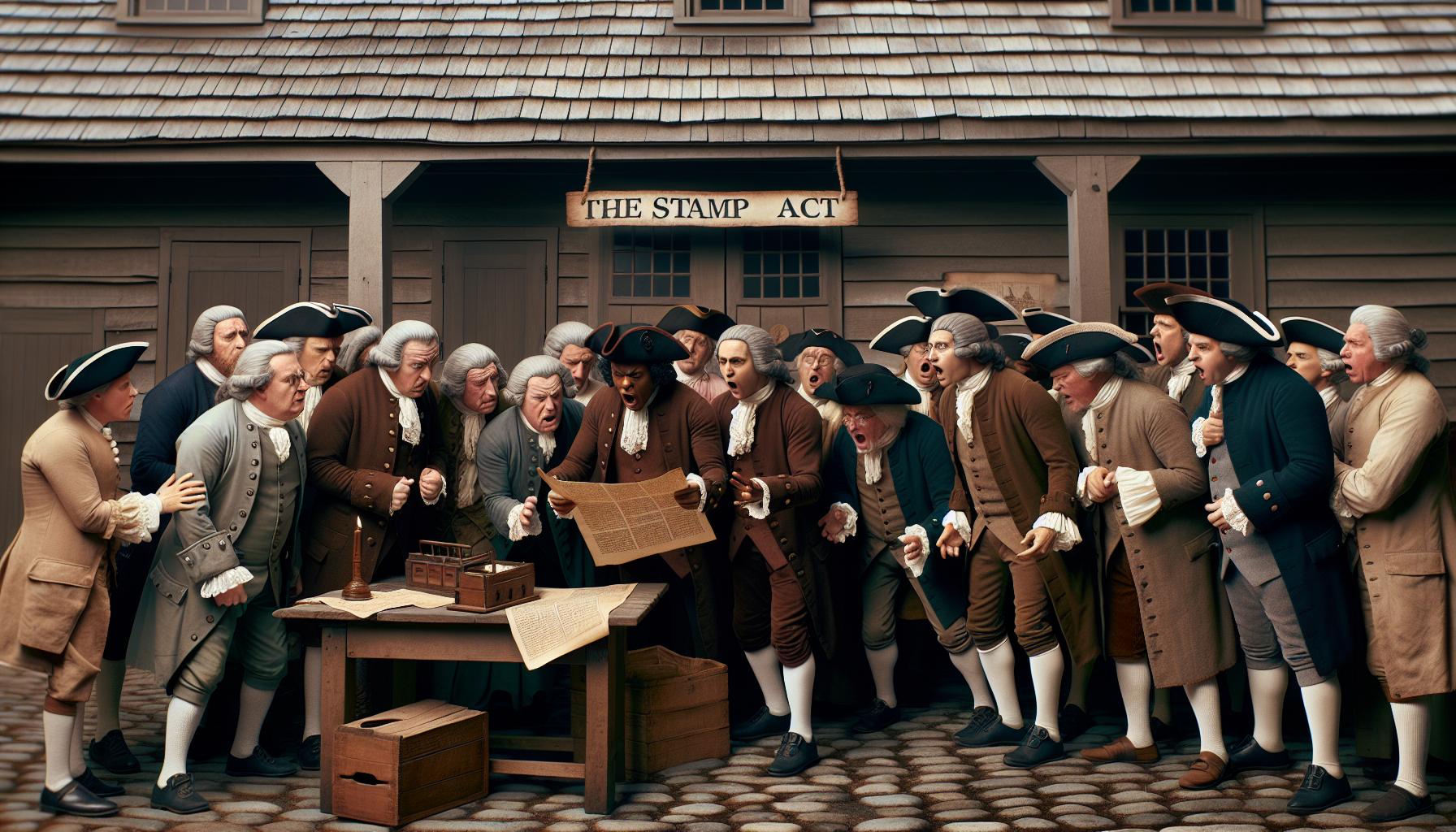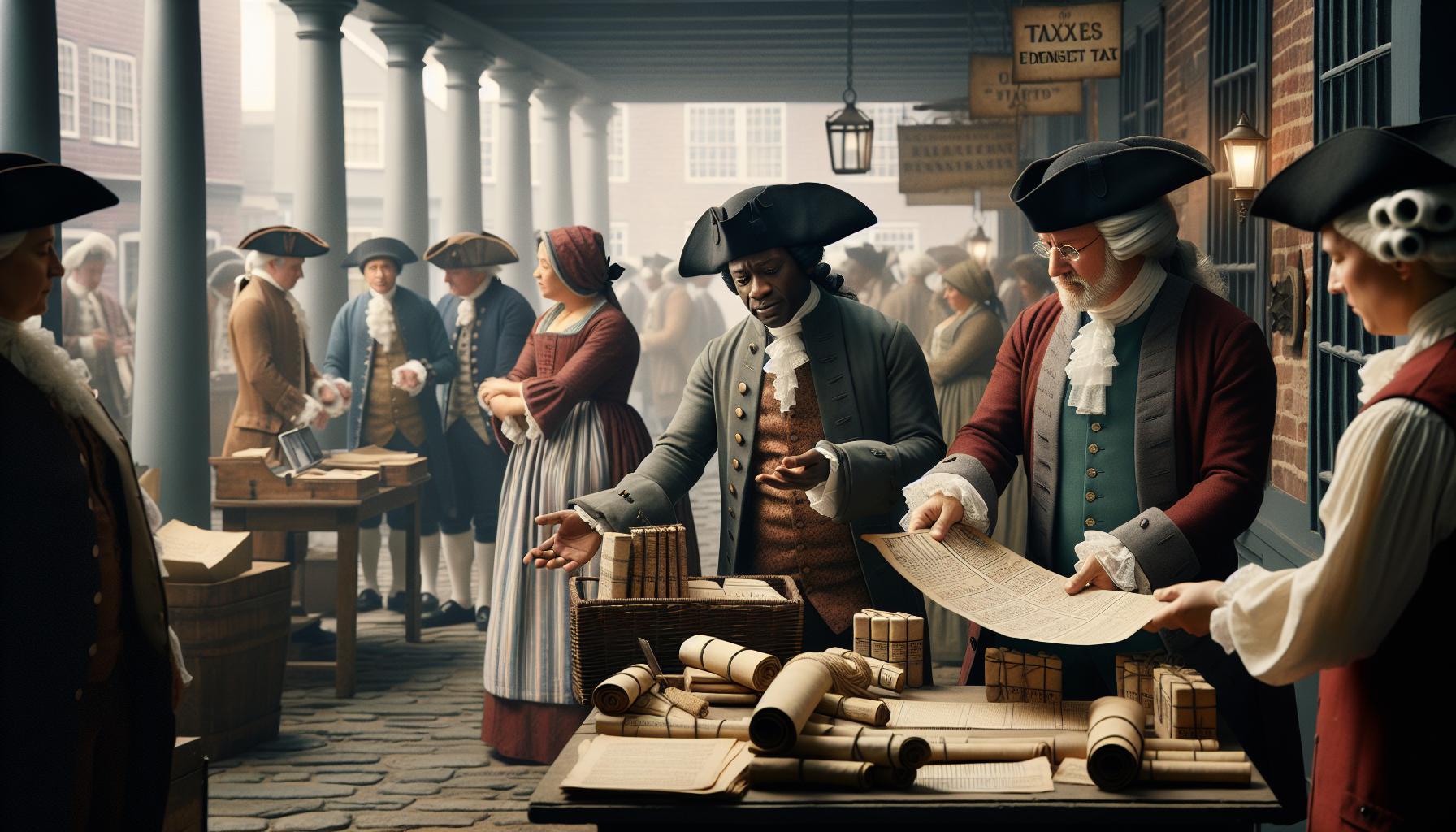Did you know that a single British tax sparked a wave of widespread protests that ultimately reshaped an entire society? The Stamp Act of 1765 imposed a direct tax on the American colonies, requiring them to pay for official stamps on various printed materials. This law ignited intense opposition and united the diverse colonies in a fight against what they saw as unfair taxation without representation. Understanding how colonists reacted to the stamp Act protests reveals not only their strategies of resistance-ranging from organized boycotts to public demonstrations-but also the beginnings of a collective American identity. Exploring these reactions offers valuable insights into how ordinary people confronted political injustice and set the stage for revolutionary change, a story that remains relevant whenever communities push back against unfair policies today. as you read on, you’ll discover the powerful ways colonists channelled their frustration into action, highlighting the roots of early American unity and resistance. This understanding can deepen your thankfulness of how protest movements can influence governments and shape history.
Colonial Public opinion and Initial Reactions to the Stamp Act
From the moment news of the Stamp Act reached the American colonies,it sparked an immediate and widespread wave of shock and anger. Unlike previous trade regulations primarily targeting merchants,this law imposed a direct internal tax on a broad range of printed materials-legal documents,newspapers,even playing cards-affecting virtually every segment of colonial society. Colonists had never been taxed so explicitly without their consent, and this new levy was viewed as a profound violation of their rights as Englishmen. The principle of “no taxation without representation” quickly became a rallying cry, uniting diverse groups in opposition to what was seen as parliamentary overreach.
Public opinion grew sharply critical as word spread, fueled by local leaders and vocal opponents who articulated the colonists’ frustrations. Town meetings and colonial assemblies erupted with protests, where citizens debated the legitimacy of the tax and strategies for resistance. The Stamp Act’s impact cut across social classes, causing anger not only among elite lawyers and merchants-whose documents and contracts bore the stamp-but also printers, journalists, and ordinary citizens who relied on pamphlets and newspapers for information. This broad-based discontent helped transform what might have remained a localized grievance into a shared colonial crisis.
Factors Fueling Initial Dissent
- Political Representation: Colonists condemned the taxation imposed by a Parliament in which they had no elected voice, seeing it as a direct threat to their political autonomy.
- Economic Burden: While the tax itself was modest, the symbolic weight and precedent it set alarmed many, prompting concerns about future, heavier levies.
- Legal and Social impact: The requirement that all legal and commercial documents carry a government-issued stamp was viewed as not only a financial burden but also an encroachment on the everyday operation of colonial society.
Early reactions included a mix of formal petitions, boycotts of British goods, and widespread refusal by colonial officials to enforce the tax. In New York, for example, resistance was robust enough to impede the actual collection of the tax, illustrating how public opinion translated quickly into effective obstruction. The Stamp Act Congress, convened later in 1765, was itself a testament to the growing unity among colonies, born out of this shared backlash against the perception of unjust taxation imposed from across the Atlantic [[1]](https://digitalcommons.buffalostate.edu/history_theses/44/), [[2]](https://en.wikipedia.org/wiki/Stamp_Act_1765).
For modern readers looking to understand the dynamics behind colonial resistance, it’s valuable to recognize how immediate and organized the reaction was-rooted deeply in a shared belief in constitutional rights and fueled by early communication networks including newspapers and pamphlets that spread ideas rapidly. These factors combined to create a powerful popular movement before any formal legislative assemblies took decisive action, showing the importance of public sentiment and grassroots mobilization in shaping ancient outcomes.
Economic Impact of the Stamp Act on Different Colonial Groups
The Stamp Act’s economic repercussions rippled widely,hitting various colonial groups in distinct ways that transformed their perspectives and fueled resistance. While the direct tax itself might seem modest by modern standards, its financial and symbolic burden was profound, shaping not only the livelihoods but also the political consciousness of many colonists.
Merchants and lawyers faced immediate and tangible costs, as virtually all legal documents, contracts, licenses, and commercial papers required stamped paper bearing the new tax. For merchants, this meant increased transaction costs and friction in routine trade dealings. Many relied on a steady flow of paperwork to conduct everyday commerce,so the tax threatened to slow buisness and diminish profits. Lawyers and judges, who depended heavily on official documents-wills, deeds, court filings-saw their professional expenses rise, making legal transactions more costly and complex for their clients. This group, wielding considerable local influence, quickly became vocal critics, viewing the tax as an interference that hurt their economic interests and legal autonomy alike.
Printers and publishers were another group significantly affected. The Stamp Act taxed newspapers,pamphlets,and even playing cards,all of which played a central role in colonial communication and entertainment. Printers bore the direct brunt of increased costs, which often had to be passed on to readers. This not only threatened their business survival but also provided a powerful platform for protest. Printers used their presses to disseminate pamphlets and broadsides condemning the Act, linking economic hardship with political rights and fueling public outrage.Ordinary colonists, many of whom avidly read these materials, felt the impact indirectly as printed goods became more expensive, stirring widespread discontent.Meanwhile, small farmers and ordinary citizens experienced the economic impact somewhat differently. While they may not have dealt directly with stamped documents daily, the tax touched their lives through increased prices on essential goods and services that depended on official paperwork-land sales, contracts, and receipts. even playing cards, frequently enough used in social settings, were taxed, symbolizing the legislature’s reach into the everyday lives of all social strata.
Unequal Burdens and Unified Resistance
- Merchants & lawyers: Burdened by increased costs in commerce and legal matters, they leveraged political influence to organize opposition.
- Printers & Publishers: Faced with direct business losses, they became vocal critics, using their publications as tools of resistance.
- Small Farmers & Common Citizens: Impacted indirectly but broadly, their growing frustration helped translate elite resistance into popular protest.
Understanding these economic dynamics reveals why the Stamp act generated such a powerful, cross-class coalition against British taxation policies. The tax was a catalyst that transformed economic grievances into a wider political movement. for readers looking to connect historical events with practical lessons,this episode highlights the importance of:
- Recognizing how policy changes can have varying economic impacts within different sectors of society.
- Appreciating the role of business interests (like merchants and printers) in shaping political discourse.
- Understanding that even seemingly small taxes or costs-especially when imposed without representation-can unite diverse groups when perceived as unjust.
These insights show how economic pressures fueled both direct and symbolic resistance, underscoring the interconnectedness of economic wellbeing and political rights in colonial America’s tumultuous journey toward independence.
| Colonial Group | Type of economic Impact | Example | Response |
|---|---|---|---|
| Merchants & Lawyers | Increased costs on legal and commercial documents | Taxes on contracts and shipping papers | organized petitions, boycotts, legal challenges |
| Printers & Publishers | Direct tax on newspapers, pamphlets | Costly stamped paper for printing | Vocal public opposition through print media |
| Small Farmers & Citizens | Indirect costs through higher prices, taxed playing cards | Purchase of land deeds, everyday taxed items | Grassroots protests, participation in boycotts |
Organized Colonial Protests and Formation of the Sons of Liberty
Few moments in early American history illustrate the raw power of organized grassroots protest better than the rapid emergence of colonial resistance groups following the Stamp Act. When the British Parliament imposed this direct tax on all printed materials, it ignited a wave of outrage that transcended economic classes. Early opposition quickly evolved from scattered complaints into coordinated action, spearheaded by groups committed not only to opposing the tax but also to defending the principle of “no taxation without representation.”
One of the most influential and well-organized groups to arise from this turmoil was the Sons of Liberty. Formed during the summer of 1765, this secret society was composed primarily of merchants, lawyers, artisans, and other influential colonists who realized the need for unified defiance. Their activities ranged from orchestrating public demonstrations and rallies to intimidating tax officials and dismantling stamped paper supplies. The sons of Liberty expertly combined symbolic protests-such as effigies and public gatherings-with practical tactics like economic boycotts to exert pressure on British authorities.
Strategies That United Diverse Colonial Interests
The group’s success lay in its ability to strike a balance between visible public resistance and covert operations. For example, they organized widespread nonimportation agreements, encouraging merchants and consumers to boycott british goods, which affected the economy at multiple levels. These boycotts empowered ordinary colonists to participate in the political cause by simply withholding their economic support from British imports, thereby turning consumer choices into acts of protest. Meanwhile, more aggressive tactics-such as protests that sometimes escalated to violence against stamp distributors-intensified colonial unrest and made the enforcement of the Stamp Act nearly impractical.
Lessons on Building Effective Resistance Movements
Colonial leaders understood that resistance needed coordination across towns and colonies to increase its effectiveness, a concept ahead of its time. The Sons of Liberty often communicated through written correspondence and local networks, sharing strategies and news of actions elsewhere. For modern readers,this illustrates the importance of building structured,communication-focused movements when addressing widespread grievances. Mobilizing support by appealing to shared economic and political concerns allows disparate groups to unite under a common cause, amplifying collective power.
- Unity across social and economic lines magnified the movement’s legitimacy and impact.
- Blending peaceful and assertive tactics kept opposition dynamic and unpredictable.
- Leveraging networks and communication facilitated coordination and rapid response.
By understanding how the Sons of Liberty leveraged social influence,economic pressure,and public demonstration,today’s activists and organizers can learn valuable lessons about building resilient coalitions. Their story highlights how organized action, grounded in shared grievances and strategic planning, can transform scattered dissent into a powerful force for change.
The Role of Colonial Newspapers and Pamphlets in Shaping Resistance
From the moment the Stamp Act was introduced, colonial newspapers and pamphlets became the frontline instruments of resistance, turning print media into powerful agents of political mobilization.These publications circulated vital information, shaped public opinion, and connected disparate communities by transforming abstract grievances into a shared colonial narrative. With literacy rates relatively high among free men and access to printed materials common in urban centers, newspapers and pamphlets were uniquely suited to spark conversation and organize collective action against the tax.
Pamphlets, in particular, served as what we might think of today as social media or viral content-short, focused, and rapidly reproduced-making complex arguments accessible and emotionally compelling to a broad audience.Many pamphlets exposed the injustice of taxation without representation and explained its dangerous precedent for colonial autonomy.their pointed critiques were often laced with persuasive rhetoric and vivid illustrations, galvanizing readers to reject British policies. Newspapers added regular commentary, editorial pieces, and reports on protests, effectively sustaining momentum and enabling colonists to track resistance efforts beyond their local towns.
- Widespread Distribution: Printing presses in cities like Boston, Philadelphia, and New York ensured that anti-stamp Act messages crossed regional boundaries, fostering a sense of pan-colonial unity.
- Amplification of Voices: Papers gave space to influential leaders, articulating grievances and providing a platform for debate that helped clarify the stakes for citizens.
- Mobilization Tool: Notices for town meetings,protests,and boycotts published in newspapers were crucial for coordinating collective actions such as the nonimportation agreements endorsed by protest groups.
Effective Communication Strategies in Print
The success of colonial print media lay in its ability to combine information, persuasion, and urgency. Writers used accessible language and powerful symbolism-common motifs like the liberty Tree or the image of chained hands-to make ideas resonate emotionally. This approach helped spread political awareness beyond elites, involving artisans, merchants, and laborers in a growing resistance movement. Moreover, the circulation of these materials encouraged readers to think critically about governance, rights, and the legitimacy of British authority, sowing the intellectual seeds for revolutionary thought.
For modern readers looking to understand or replicate such grassroots communication success, consider the following takeaways:
- Timely dissemination: Rapid and consistent communication keeps movements energized and communities informed.
- Emotional resonance: Stories, symbols, and clear calls to action strongly influence public engagement.
- Inclusivity in messaging: Using language and formats accessible to diverse groups broadens participation and solidarity.
Ultimately, colonial newspapers and pamphlets did far more than report events-they helped create a shared colonial identity rooted in resistance. Their legacy is a testament to the power of the printed word in shaping public opinion and driving social change during the tumultuous years following the Stamp Act’s imposition.[3] | [2]
Violent and Nonviolent Tactics Used Against Stamp Act Enforcement
Resistance to the Stamp Act unfolded through a rich tapestry of both violent and nonviolent tactics, reflecting the diverse strategies colonists employed to challenge British authority. From the outset, many colonists understood that direct confrontation with British soldiers and officials could carry severe consequences, yet the escalating sense of injustice over taxation without representation pushed some groups toward more aggressive measures.Early on, nonviolent strategies centered around economic pressure and public demonstration proved remarkably effective. Merchants, artisans, and traders coordinated widespread nonimportation agreements, refusing to buy or sell British goods until the Stamp Act was repealed. This boycott strategy targeted British economic interests directly, leveraging colonial consumer power as a peaceful yet potent form of protest. Public town meetings and assemblies also served as forums for collective decision-making and vocal opposition, signaling unified colonial dissent without resorting to violence.
However, as tensions intensified, more confrontational actions emerged. Groups such as the Sons of Liberty spearheaded forceful measures designed to intimidate and disrupt Stamp act enforcement. These often involved the public humiliation, threats, and sometimes physical assault of stamp distributors, effectively coercing many officials to resign their posts. One infamous tactic was the use of effigies-lifelike puppets or dummy figures representing tax collectors-displayed in town squares or hung from “Liberty Trees” to publicly shame and pressure opponents. In some instances, mobs forcibly destroyed stamp paper or attacked customs officials’ property, actions that blurred the line between protest and mob violence.
Nonviolent Tactics with Lasting Impact
- boycotts and Nonimportation Agreements: These economic sanctions spread quickly, uniting disparate colonies in a common cause and creating financial strain on British merchants, who then lobbied Parliament to repeal the Act.
- Public Resolutions and Petitions: Formal statements such as those from the Stamp Act Congress articulated colonial grievances and called for legal redress, emphasizing peaceful negotiation.
- Community Solidarity Events: Rallies, parades, and symbolic acts like hanging effigies served as collective outlets for dissent-visible and sobering reminders of colonial opposition.
Escalation to Direct Confrontation
While many viewed violence as a last resort, colonial resistance increasingly involved direct intimidation tactics to ensure compliance with boycotts and protest declarations. For example, stamp distributors who attempted to collect taxes found their houses threatened, and some fled for safety. This blend of psychological and physical pressure effectively undermined British administrative efforts. The dual approach ensured that resistance was widespread, with peaceful protesters providing moral legitimacy, and militant actors applying intense localized pressure where necessary.
These actions highlight a critical lesson for understanding social movements: combining targeted nonviolent resistance with measured displays of strength can create a powerful dynamic, expanding participation while pressuring reluctant or repressive authorities.
For modern activists or communities facing unpopular policies, the Stamp Act resistance offers practical insights:
- Create broad, inclusive economic boycotts to apply material pressure without provoking severe crackdowns.
- Use symbolic imagery and organized public events to unify participants and sustain morale.
- Leverage both peaceful negotiation and strategic intimidation judiciously to maximize impact while maintaining public support.
By carefully balancing forceful tactics with principled nonviolence, the colonists set a precedent that would influence the methods of subsequent revolutionary movements across the world.
blank”>Source | blank”>Learn More
Impact of Stamp Act Congress and Intercolonial Unity Efforts
One of the most remarkable outcomes of the colonial response to the Stamp Act was the unprecedented level of cooperation it inspired among the thirteen disparate colonies. The Stamp Act Congress, convened in New York City in October 1765, marked a pivotal moment where representatives from seven colonies-later joined in spirit by many others-came together to articulate a united colonial stance against British taxation policies.[3] This gathering was not only revolutionary as it coordinated colonial resistance but because it laid the groundwork for future intercolonial collaboration,a crucial ingredient for the eventual success of the American Revolution.
This Congress produced the “Declaration of Rights and Grievances,” a formal document asserting that only colonial assemblies had the legal authority to tax the colonies. This declaration sent a clear and powerful message to the British Crown and Parliament: the colonies were united in demanding recognition of their rights and political voice. By bringing together delegates from multiple colonies, the Stamp Act Congress helped to synchronize efforts on protests, boycotts, and petitions, increasing their overall effectiveness. The coordination of collective economic resistance, such as the widespread nonimportation agreements, was an extension of this unity and arguably one of the most powerful tools colonists wielded in compelling British repeal of the Act.[1]
The practical benefits of such unity went beyond shared declarations. It fostered a sense of shared identity and mutual reliance that transcended local interests. Colonists began to view their struggles through a larger regional lens rather than purely individual or provincial grievances, a shift crucial to sustaining momentum. For example, merchants in Boston understood how their boycott could impact trade patterns in Charleston or New York. This solidarity allowed colonies to pool resources, exchange information, and amplify their political voice within and outside colonial borders.
Lessons from Colonial Unity
- Collective action strengthens leverage: When confronting a distant and powerful adversary, no single group can realistically expect success alone. The Stamp Act Congress exemplifies the power of alliances in amplifying impact, a strategic lesson applicable to contemporary advocacy and political movements.
- create forums for communication and problem-solving: Establishing representative bodies or regular meetings enables diverse groups to find common ground and coordinate efforts effectively, reducing duplication and internal conflict.
- Formal declarations can clarify goals and unify diverse constituencies: Written statements like the Declaration of Rights helped solidify shared principles and provided a clear platform from which to negotiate or resist.
Ultimately, the Stamp Act Congress was a prototype for later continental congresses, setting a precedent for colonial collaboration in the face of imperial policies. It transformed isolated protests into a sustained, coordinated movement that held Britain accountable and showcased the growing political maturity of the colonies. for anyone today looking to build impactful resistance or advocacy campaigns, taking a page from this history means prioritizing unity, clear communication, and strategic cooperation-elements that remain essential for overcoming entrenched power structures.
British Government Response to Colonial Backlash
The British government’s reaction to the widespread colonial resistance to the Stamp Act was a blend of initial firm resolve followed by pragmatic retreat-a response shaped by both political pressures at home and the realities unfolding across the Atlantic. Expecting compliance,Parliament was taken aback by the scale and intensity of the backlash,which swiftly united diverse colonial interests against the tax. This demonstrated a miscalculation of colonial sentiment and the strength of emerging American political identity.
From the British viewpoint, the Stamp Act was intended to help cover the enormous debt incurred during the Seven Years’ War and to assert parliamentary authority over its overseas territories. However, the effectiveness of colonial protests-ranging from economic boycotts to vocal political opposition-soon compelled British leaders to reconsider their approach. By early 1766, the government repealed the Stamp Act, recognizing that enforcing it would not only be logistically challenging but politically damaging. This repeal was accompanied by the Declaratory Act, which reaffirmed Parliament’s right to legislate “in all cases whatsoever,” signaling a refusal to concede on ultimate sovereignty despite the practical concession.
Balancing Authority and Practicality
The British response highlighted a strategic balancing act. While the repeal showcased responsiveness to colonial economic pressures, it also revealed the limits of imperial control in the face of unified colonial resistance.British officials increasingly saw the need for a measured approach-punitive enough to maintain authority but flexible enough to avoid widespread alienation. The episode influenced subsequent policies, such as the Townshend Acts, which attempted to refine the balance between revenue generation and political control. Historians often point to this pattern as evidence of the evolving imperial mindset in dealing with distant colonies.
- political Lessons for British Governance: The stamp Act crisis underlined that colonial governance required more nuanced engagement with local assemblies and public opinion, not just top-down decrees.
- Practical Enforcement Challenges: The logistical difficulties of enforcing the Stamp Act-especially amid widespread noncompliance and intimidation of tax collectors-exposed the practical limits of imperial authority.
- Symbolic Power of Legal Instruments: The Declaratory Act served as a symbolic reaffirmation of Parliament’s supremacy while allowing the immediate economic conflict to ease.
What this Means for Understanding Conflict Resolution
The British reaction paints a valuable picture of how entrenched power structures may respond to grassroots opposition: initial enforcement and resistance, followed by concession coupled with reaffirmation of ultimate control. For modern readers, this historical case highlights the importance of recognizing considerable opposition early, adapting strategies pragmatically, and balancing authority with sensitivity to public sentiment. Whether in politics, business, or social movements, understanding when to negotiate, when to hold firm, and how to communicate authority under pressure is key to sustainable conflict management.
Ultimately,the British government’s mixed response to colonial protests over the Stamp Act set the stage for the complex,often fraught negotiations that would follow in the years leading up to the American Revolution. It revealed the growing empowerment of colonial voices and foreshadowed the limits of customary imperial power in the face of coordinated resistance movements.
Long-Term Effects of Stamp Act Protests on Revolutionary Sentiment
Resistance to the Stamp Act did far more than secure the repeal of a single tax; it ignited a profound transformation in colonial identity and political thought that shaped the path toward revolution. The protests created a shared experiance of opposition across diverse colonial regions,transcending individual grievances to foster a collective sense of empowerment and political consciousness. This newfound unity was unprecedented and helped lay the groundwork for later revolutionary acts,as colonists began to view their rights not as privileges granted by the Crown but as inherent liberties to be defended against external overreach.
One of the most critical long-term consequences was the widespread adoption of the principle “no taxation without representation,” which shifted political discourse from isolated complaints about unfair taxes to fundamental debates about legitimate governance and authority. This slogan encapsulated growing skepticism toward Parliament’s right to tax the colonies without their consent, influencing not only public opinion but also colonial legal thought and legislative actions. Communities that had once been loosely connected started to coordinate protests, share intelligence, and develop political organizations, signaling a move toward a more structured and strategic resistance movement.
Building Blocks of Revolutionary Infrastructure
The strategies and networks developed during the Stamp Act protests became vital assets for future revolutionary activities.The Sons of Liberty, initially formed to oppose the Stamp Act, evolved into a broader political force advocating for colonial rights. Similarly, colonial newspapers and pamphlets that had initially circulated arguments against the tax helped foster widespread political literacy and debate, turning public opinion into a powerful tool for mobilization. Understanding the lasting role of communication in movement-building offers practical lessons even today: creating accessible, compelling narratives and fostering open channels of information are crucial for any grassroots effort.
Practical Insights from Colonial Resistance
- Unity from Diversity: Bringing together disparate groups around a common cause can build resilience and amplify influence, especially when addressing complex governance issues.
- symbolic Language Matters: Clear, relatable slogans like “no taxation without representation” can distill complex principles into rallying cries that unite people across regions and classes.
- Organized Communication: Utilizing multiple media channels strengthens mobilization efforts and maintains momentum in prolonged political struggles.
The Stamp Act crisis also hardwired a cautious recognition of British political strategy among the colonists. They began to see that concessions might come, but these were tactical rather than genuine shifts in power.This dual awareness-hope for change tempered by realism about imperial intentions-fueled a balanced but persistent escalation of resistance, which ultimately culminated in the American Revolution. For those studying political movements today,the Stamp Act protests exemplify how early organized opposition combined with clear strategic messaging can cultivate durable revolutionary sentiment that outlives initial victories.
Frequently Asked Questions
Q: How did different social groups in the colonies uniquely respond to the Stamp Act protests?
A: Different social groups reacted to the Stamp Act protests in distinct ways. Merchants organized boycotts, artisans joined public demonstrations, and rural farmers often resisted tax collectors directly. Understanding these varied reactions helps deepen insight into the widespread colonial resistance beyond urban centers. For more, see the section on economic Impact of the Stamp Act on Different Colonial Groups.
Q: What role did women play during the Stamp Act protests?
A: Women played a critical supporting role in the Stamp Act protests by organizing non-importation agreements and spreading political messages within households. Their participation helped sustain boycotts and influence community attitudes, highlighting a broader grassroots involvement beyond public demonstrations.
Q: How did local colonial governments or town meetings react to the Stamp Act protests?
A: colonial governments and town meetings often acted as platforms to coordinate resistance against the Stamp Act. They passed resolutions condemning the tax and endorsed boycotts, fostering legal and political opposition that complemented grassroots protests. This is closely related to the Impact of Stamp Act Congress and Intercolonial Unity Efforts.
Q: Why were some colonists hesitant or opposed to Stamp Act protests despite widespread opposition?
A: Some colonists opposed or hesitated to protest due to fears of economic backlash, loyalty to Britain, or concerns over violent tactics. This division highlights early complexities in colonial unity and sheds light on differing views of British authority during the period.
Q: How did the Stamp Act protests influence colonial relationships with Native American groups and enslaved people?
A: the Stamp Act protests mostly focused on British taxation but also subtly impacted colonial relations with native American groups and enslaved people. Some leaders hoped these groups might support protests, while others feared unrest. This aspect reveals the wider social ripple effects beyond white colonial populations.
Q: What impact did the geography of the colonies have on the intensity and methods of Stamp Act protests?
A: Geographical factors shaped protest intensity, with port cities like Boston seeing more violent confrontations, while rural areas used more passive resistance like noncompliance. Recognizing these regional differences helps explain the diverse colonial responses detailed in Violent and Nonviolent Tactics Used Against Stamp Act Enforcement.
Q: How effective were artistic expressions,such as songs and cartoons,in advancing Stamp Act protest messages?
A: Artistic expressions like political cartoons and protest songs were powerful tools that spread anti-Stamp Act sentiment widely. They simplified complex arguments, boosted morale, and rallied communities, complementing printed pamphlets and newspapers covered in your article.
Q: When did public support for the Stamp Act protests peak, and what events triggered the decline of resistance?
A: support for stamp Act protests peaked in mid-1765 following widespread boycotts and riots but began to decline after Parliament repealed the Act in 1766. The repeal, triggered by sustained colonial resistance and British economic pressures, marks a crucial turning point explored in british Government Response to Colonial Backlash.
Explore these nuanced perspectives in your article to enrich understanding of the Stamp Act protests and engage your readers deeper into colonial America’s revolutionary roots.
future Outlook
Understanding the colonists’ reactions to the Stamp Act protests reveals not just their resistance to unfair taxation, but a pivotal moment in shaping American identity and unity.Their collective efforts-from boycotts to public demonstrations-highlight how grassroots activism can influence political change. To deepen your insight, explore our detailed analysis of the Boston Tea Party and the broader causes of the American Revolution, which provide essential context for these events.
If you found this overview helpful, don’t miss out on subscribing to our newsletter for regular updates on early American history and related topics. Curious about how taxation influenced other colonies or the Crown’s response? Check out our resources on colonial taxation and British policies to continue your journey. Share your thoughts or questions below-your engagement helps us create content that matters. Together, we can uncover more about the motivations and repercussions behind the Stamp Act protests, keeping history vivid and relevant.








